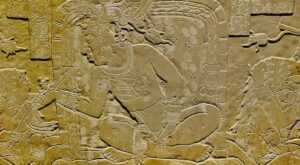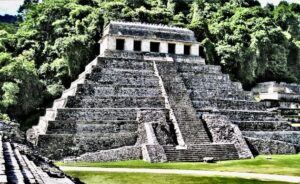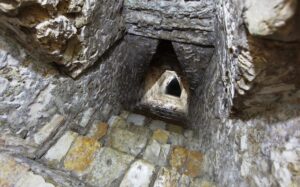
The iconography of the Maya tombstone in the Temple of the Inscriptions has raised more questions than well-founded answers. A close look at the tombstone, its setting and history, may help understand the Maya timeless message about life and death. The Temple is the final resting place of K’inich Janahb’ Pakal Ahaw, Lord of the B’aakal kingdom at Lakamha’, near today’s Palenque in Chiapas, Mexico, where he was born on March 13, 603. From the end of the fifth to the late ninth century, Lakamha’ was an important metropolis and a major regional player in politics, trade, and architecture. Pakal ruled the kingdom from 615 to 682, making him one of the longest-reigning Maya monarchs in history………..
As holy lord of the B’aakal kingdom, Pakal was supreme in secular and religious matters, superseding the high priest and priestess, for the prefix K’inich means Lord, while Ahaw connotes Holy. The Maya called their kings ch’ul ahaw or “lords of the life force,” for the universal power vested in them by the gods. He, and he alone, was anointed by the gods of the unifying forces of light of the Otherworld and those of darkness of the Underworld. In the Maya cosmology, these “worlds” were understood as “complementary opposites” for, paradoxically, both were in turn friendly and hostile over humans and nature. For these reasons, they needed to be pacified through rituals at dedicated times such as, among others, planting and harvesting and important communal milestones.
________________________________

Temple of the Inscriptions @georgefery.com
________________________________
In the last decade of his life, Pakal and his architects worked on his funerary monument, the Temple of the Inscriptions, facing the ancient city’s central plaza.
The temple is the most remarkable sanctuary ever built in Mesoamerica. The eight-level funerary pyramid, and the temple at its summit making up its ninth level, was designed by Pakal and his architects, who started its construction around 675, when Pakal was seventy-two years old. The structure was completed about five years before his death on August 8, 683. The temple at its top was dedicated on December 23, 688, by his son and heir, K’inich K’an B’ahlam (635-702), in time for his father’s funeral. The stepped pyramid’s foundations reach over ten feet below the central plaza’s grounds. The structure was originally covered with plaster that may have been painted red, for remains of pigment were found; of note is the absence of carvings on its stones. The name Temple of the Inscriptions comes from three large limestone panels found on the walls of the temple’s front corridor. In the past, the stepped pyramid was known as “Temple of the Laws” because on those panels are 617-glyphs that narrate Pakal’s achievements and proclaim his place in eternity.
The six piers atop the pyramid are adorned with stucco scenes. As noted by scholars, “we may never know what Pakal intended to display on the piers, for K’an B’ahlam, who completed the temple after his father’s death, took this public location to show the rituals in which he became heir to the throne and proved his divine nature.” In ancient Maya cosmology “the pyramid replicates the“First-True-Mountain of the World Rising out of the Primordial Waters of Creation” (Schele, Matthews, 1993, 1998). The crypt, located in the deepest recess of the pyramid, is associated with caves perceived as portals to the water world, for water is integral to the belief in the beginning of life in Maya cosmology, where the “Otherworld” points to a mythic world “above” the human plane, abode of the sun, beneficent gods, and life. Its opposite, the “Underworld” or world “below” is associated with sunset, the moon, malevolent gods, and death. The world of the living, between these two man-made worlds, is the “Middle World.” As Bassie-Sweet point out, “One of the most important structuring principles in Maya worldview was complementary or contrasting opposites, such as male/female, right/left, east/west, day/night, up/down or north/south” (2008).
___________________________________

Temple of the Inscriptions, Cutaway @pueblosoriginarios.com
___________________________________
To build the pyramid, not only did architects, master stonemasons and carvers answer Pakal’s architectural requirements, they also followed a sacred allegorical pattern that was beyond their professional expertise, helped in their tasks by calendar priests, knowledge keepers and wizards. For the burial ceremony, Pakal and his chu’lel – his “divine life force” or “blessed substance of the living universe” – were first brought from the palace up the pyramid’s front stairs. The stairs of the pyramid follow, as does the pyramid’s architecture, the four sacred directions of the Maya equilateral cross, the wacah chan or “world tree.” Each arm of the cross is associated with colors, deities, and functions. The pyramid faces northward onto Palenque’s main plaza. Climbing the stairway up to the temple, Pakal and his retinue faced South>yellow-Nohol (K’an Xib’Chac, germ of life, origin of the winds). After prayers, rituals, and invocations in the temple, Pakal’s body and his chu’lel’ were carried down the three sets of the intramural stairways leading down to the crypt. The first flight of stairs followed the path of the Sun, so Pakal and his retinue walked down heading East>red–Lakin (Chac Xib’Chac, sunrise, dawn). At mid-level, the second set of stairs sharply turns West>black-Ek (Ek Xib’Chac, sunset, dusk). Pakal’s last short five steps stairway into the crypt led him North>white–Xaman (Zac Xib’Chac, the resting place of the winds).
________________________________

First Flight of Stairs @georgefery.com
________________________________
When Pakal was placed in his coffin, his head pointing north, he transitioned from a divine king to a celestial ancestor. As the last rituals and invocations were completed, the crypt’s massive triangular stone door was closed. In his coffin, however, Pakal was never far from the living and, for this purpose, had a narrow conduit called the Tz’at Na Kan, or “Serpent of the Wise Ones,” built to fit the stairwells. It was called a psychoduct by the renowned Mexican archaeologist Alberto Ruz Lhuillier (1906-1979), who discovered the stairwells in 1950 and the crypt in 1952. The serpent’s head is made of a mix of limestone plaster and was attached to the bottom of the sarcophagus which connected with the “psychoduct,” a rectangular limestone molding outside the door, matching each stair with a hollow round tubelike center that ended below the floor of the temple. It was the Tzat Na Kan, through which Pakal and the priests established soul-to-soul contact, not soul-to-mind, at dedicated times. This feature is found in other structures at Palenque such as in Temples XIII and XVIII, albeit not so elaborate. They each have a tube-like conduit that runs vertically from the crypt to below the temple floor, and a small hole on the sarcophagus lid was drilled at the level of the face to let the ch’ulel’ pass. These funnels bolstered the belief that the individual in the grave was still socially alive after death, with prerogatives attached to his spiritual powers, for ch’ulel’ never dies. It was then accepted, as it is today in most beliefs and religions, that a person has a body, and a soul. It was, however, the deified chu’lel’ that was the object of veneration. Upon death, while the body’s soft tissues decayed, its chu’lel remained within the skeletal bones for the duration of the person’s past life and was then reunited with the ancestors to be assigned to another life.
Read the complete article with a premium subscription.
Cover Image, Top Left: Pakal. Jebulon, Creative Commons CC0 1.0 Universal Public Domain Dedication, Wikimedia Commons
Advertisement

EXPLORE THE ANCIENT ETRUSCANS IN PERSON!
Experience a unique, up-close-and-personal hike among ancient hilltop towns in central Italy. You will walk the sensational countryside of the regions of Umbria and Tuscany, soaking in important sites attesting to the advanced Etruscan civilization, forerunners of the ancient Romans; imposing architectural and cultural remains of Medieval Italy; local food and drink; and perhaps best of all — spectacular scenic views! Join us in this collaborative event for the trip of a lifetime!




